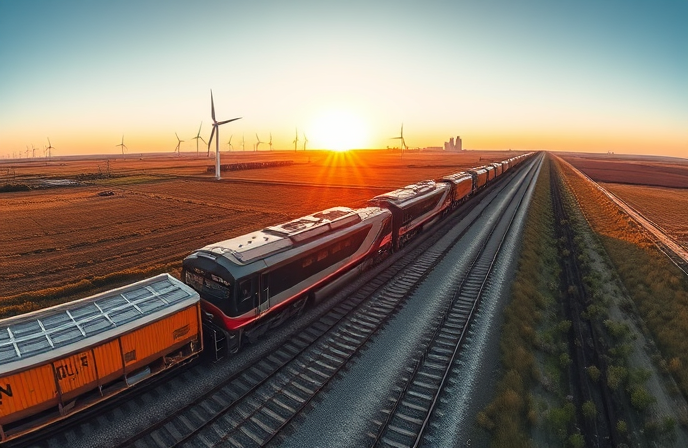Moldova’s €54M Rail Upgrade: Connectivity, Growth, & Geopolitics

The Strategic Importance of Railway Modernization in Moldova: A €54 Million Investment in Regional Connectivity
Moldova, a small yet strategically crucial nation bordering Ukraine and Romania (an EU member state), finds itself at the heart of significant geopolitical and economic shifts. Its location necessitates robust and efficient infrastructure, particularly its railway network, to facilitate trade and support regional stability. This article examines the recently announced €54 million investment (€12 million grant and €42 million loan) from the European Investment Bank (EIB) – the EU’s lending arm – for the rehabilitation and modernization of Moldova’s north-south railway corridor. This significant investment not only addresses Moldova’s internal infrastructure needs but also plays a pivotal role in supporting the EU-Ukraine Solidarity Lanes initiative, enhancing regional connectivity, and bolstering the overall economic resilience of the region. The project focuses on the revitalization of the Valcinet-Ungheni-Chisinau-Cainari railway line, a key artery for transporting goods, particularly Ukrainian grain, to international markets via Danube and Prut River ports. The implications of this project extend far beyond simple infrastructure improvements, impacting geopolitical relations, economic development, and regional stability. The analysis will explore the project’s economic benefits, geopolitical significance, its alignment with broader EU strategies, and the long-term implications for Moldova and its neighbors.
Economic Benefits and Regional Connectivity
The modernization of Moldova’s north-south railway line promises significant economic benefits. The improved infrastructure will increase the efficiency of freight transport, reducing transit times and costs. This directly impacts the competitiveness of Moldovan and Ukrainian exporters, particularly in the agricultural sector, allowing for the seamless transportation of grain and other goods to international markets. The project’s alignment with the EU-Ukraine Solidarity Lanes initiative is crucial, providing an alternative export route for Ukrainian grain in the face of disruptions in Black Sea shipping. This enhanced connectivity strengthens Moldova’s role as a vital transit hub, boosting its economy and fostering closer economic ties with both Ukraine and the EU. The increased efficiency and capacity of the railway network will attract further foreign investment, stimulate economic growth, and create job opportunities within the transportation and logistics sectors.
Geopolitical Significance and Strategic Partnerships
The EIB’s investment underscores the geopolitical significance of Moldova and its railway network. The project strengthens the partnership between Moldova and the EU, demonstrating the EU’s commitment to supporting Moldova’s economic development and its strategic stability. The rehabilitation of the railway line also enhances connectivity between Moldova and Ukraine, reinforcing their bilateral relations and facilitating greater cooperation on regional issues. This collaboration is particularly important given the ongoing conflict in Ukraine and the need for robust and reliable transit routes to facilitate trade and humanitarian aid. The project demonstrates a tangible commitment to supporting Ukraine’s efforts to maintain its export capacity and maintain its economic resilience.
Alignment with EU Strategies and Long-Term Vision
The project aligns perfectly with broader EU strategies aimed at strengthening regional connectivity, promoting economic development in Eastern Partnership countries, and fostering stability in the region. The investment falls under the EIB’s Global project, highlighting the EU’s dedication to supporting sustainable infrastructure development and economic growth beyond its borders. The improved railway infrastructure directly supports the EU’s efforts to diversify trade routes, enhance resilience against geopolitical disruptions, and foster closer economic ties with its Eastern neighbors. This strategic investment reinforces the EU’s commitment to Moldova’s long-term integration with the European Union.
Conclusion: A Catalyst for Growth and Stability
The €54 million investment in Moldova’s railway infrastructure represents a significant step towards enhancing regional connectivity, fostering economic growth, and strengthening geopolitical stability. The modernization of the north-south railway line, with its focus on the Valcinet-Ungheni-Chisinau-Cainari corridor, provides a tangible boost to Moldova’s economy by improving the efficiency and capacity of its freight transportation system. The project’s alignment with the EU-Ukraine Solidarity Lanes initiative underscores its crucial role in supporting Ukraine’s export capacity and resilience amidst ongoing conflict. Furthermore, the investment signifies a strong commitment from the European Union to supporting Moldova’s economic development and its strategic partnership with the EU. The improved infrastructure not only facilitates trade and economic growth but also strengthens regional cooperation, fostering stability and resilience in a volatile geopolitical environment. This project serves as a model for future investments in critical infrastructure across the region, demonstrating the power of strategic partnerships and investment in driving positive economic and geopolitical outcomes. The long-term impact of this project will extend beyond immediate economic benefits, contributing to a more integrated, resilient, and prosperous region. The success of this initiative will serve as a testament to the potential for international collaboration to address critical infrastructure needs and support sustainable economic growth in strategically important regions. The project’s success will be measured not only by the physical improvements to the railway lines but also by the positive economic and geopolitical impact it has on Moldova, Ukraine, and the wider region. The ongoing collaboration between the EIB, the Moldovan government, and other stakeholders will be essential in ensuring the project’s successful implementation and maximizing its long-term benefits.


